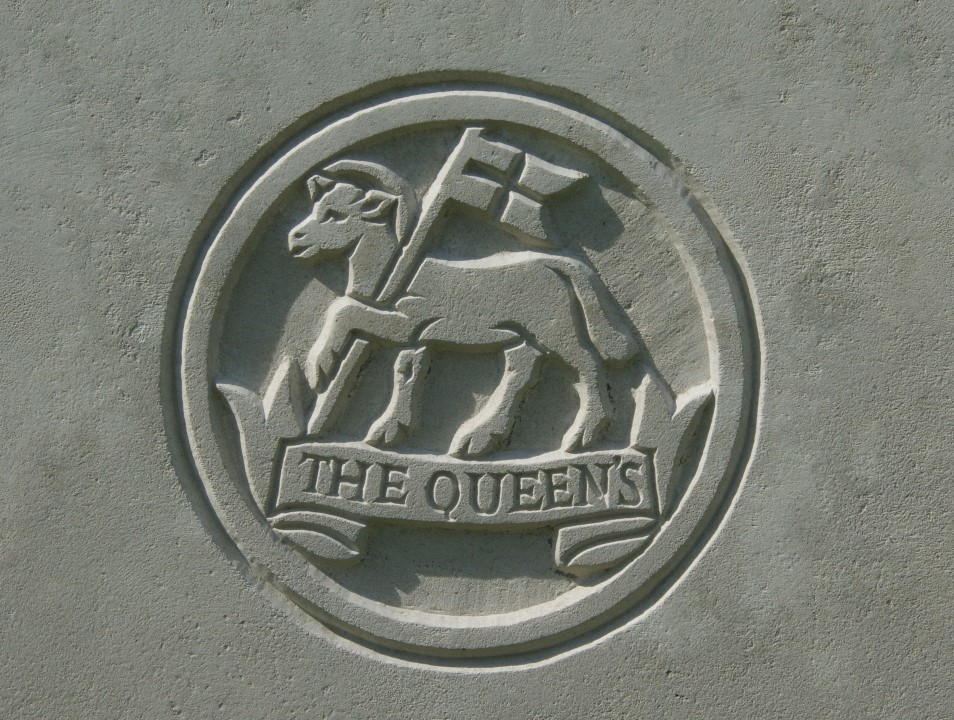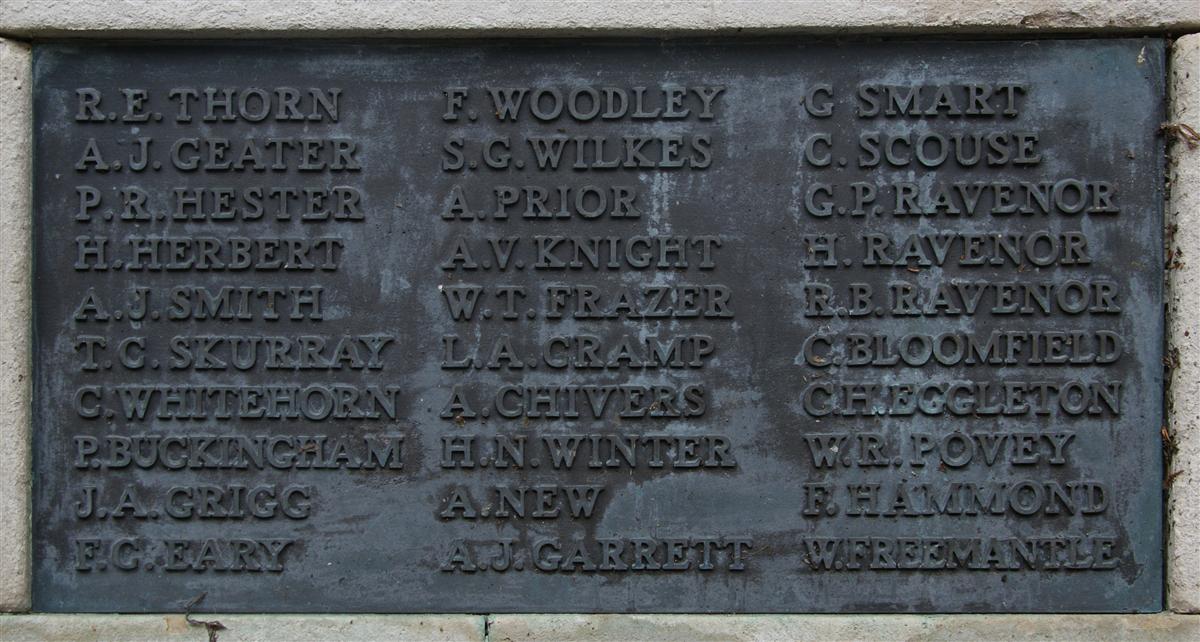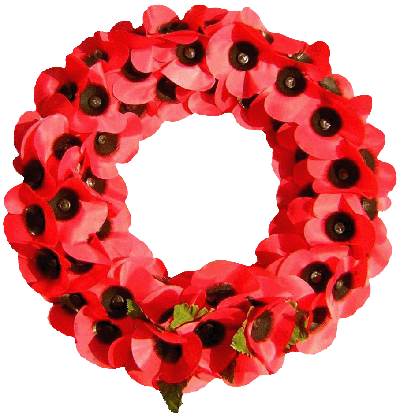Claudius Henry Charles Eggleton
Corporal G/60382 Claudius Henry Charles Eggleton, 8th Battalion, The Queen's (Royal West Surrey Regiment)
Claudius was born in Yatton, Somerset, in 1882, the son of Charles Eggleton and his wife Lucretia (née Munton and known as Kate); unsurprisingly Claudius came to be known as Harry. Charles was from Newbury, which was where the newly-weds set up home after their marriage in 1880 and where their first born, Elizabeth Ellen was born in early 1881. Harry’s birth in Yatton the following year and the birth of a third child (Edith) in Chertsey, Surrey, in 1884, suggests that Charles had to move to find work. Most of the family was still in Chertsey for the 1891 census, when Charles was working as a labourer at a local iron foundry, but, young Harry was not; he was with his grandparents Stephen and Louisa Munton who were living at 18 Oxford Street, Newbury.
This may be an early indication of problems within the marriage; by the time of the 1901 census Charles and Kate were living apart. Charles was in Dartford, Kent, described as a visitor at the home of Albert Barber and his family; ominously Charles is also described as a pauper. Meanwhile Kate was in Shepperton, Middlesex, working as a servant for an elderly widow, Mrs Mary Tulloch, and her son Arthur. There are other signs: young Elizabeth is admitted to the Girl’s British School in Newbury for a few months in 1894/5 while living with her grandparents, Edith went to school in Ockham, Surrey, for almost two years (1895-97) with the school admissions register recording a Mrs Lee as her guardian.
It is not known what had happened between Charles and Kate, but it appears to have been final; Kate disappears from records, though she may have been in contact. She died in Norfolk in 1937.
Charles returned to Newbury and found work as a house painter settling with his mother, Harriet, in a house at the northern end of Shaw Road. Edith and Harry also settled in Newbury, but Elizabeth remained in Chertsey where she married Herbert Pegrum in 1904; they named their first child Kate – suggesting that she harboured no ill-feeling for her mother.
Harry grew up and found work as a farm labourer; in 1909 he married Ada Elms. The couple settled in Ashmore Green, presumably in a cottage tied to his employment on a local farm. Their first child, Charles Henry Claudius was born on 18 February 1910, followed by Gladys (1913) and Stanley (1914). Tragically, Stanley died in 1915 within weeks of his birth.

The badge of the Queen's (Royal West Surrey Regiment) - as used on a CWGC headstone. |
Harry did not join the rush to enlist that took place in the first months of the war; he waited until late 1915 to volunteer. By this time his family were living at 8 Eastbourne Terrace in Speenhamland. He joined the Queen's (Royal West Surrey Regiment) - perhaps influenced by his time in Chertsey.
He served in France with the 3rd/4th Battalion and then the 8th Battalion. A change of battalion was often an indicator that the soldier had been wounded or seriously ill – enough to warrant a return to the UK for treatment because it was unusual to change battalion without such a break in service. However, in February 1918 the British Army went through a radical reorganisation; starved of men by Lloyd-George and unable to maintain all battalions to a reasonable strength the decision was made to abolish a quarter of the infantry battalions and reduce brigades from four battalions to three. The 3/4th Queen's disappeared in this process its personnel being used to supplement other battalions. This is probably the reason for Harry’s change of unit.
The final year of the war was the most costly for the British Army; from April to July the army reeled under the series of German attacks usually grouped together under the term Kaiserslacht (Kaiser’s Battle) or the Spring Offensive. Llloyd George was forced to release the troops he had held back in England and lower the age at which a man could be sent to the front (from 19 to 18½) in order to bolster the shattered battalions, some of which took the brunt of three major offensives. The tide turned in August when the British and Empire troops hit back at the Battle of Amiens. For the next 100 days the Allies (British, French, Belgian and American) moved forward, pushing the Germans slowly back towards the Belgian and French borders they had crossed in 1914. The Allies may have been winning, but the fighting was still deadly, more casualties were incurred during this period than in either of the great battles of 1916 (Somme) and 1917 (Passchendaele). The end came on 11 November 1918 when the Germans bowed to the inevitable, accepted the Allied terms of unconditional surrender and an armistice that ended the fighting.
However, the end came too late for Harry; he died in action on 6 November, five days before the armistice. The battalion war diary tells the story of a busy day, typical of the time. Trench warfare was a thing of the past, the British were pushing north and east towards the Belgian border – back in the area they passed through on the way to Mons in August 1914. Ground was taken step by step, facing German rearguard action from hastily improvised positions. Villages had to be cleared, often house to house – the German army was beaten, but had yet to finally admit it.
War Diary, 8th Battalion, The Queen's (Royal West Surrey Regiment) – 6 November 1918.
Le Pissotiau The 1st Royal Fusiliers attacked at dawn on the left, but were unable to get further than the River HOGNEAU. At 08.30 hrs C Coy sent a patrol into ST WAAST to endeavour to clear it and another patrol across the River de CAMBRON to gain the Railway Cutting N.E. of LE MAY, as the enemy had apparently gone back from this stream. C Coy were then ordered to follow up both of these patrols and if possible push through ST WAAST and up the railway to the Cemetery. At 09.00 Batt HQ were moved to COURTILFOI FARM. Meanwhile OC B Coy on the right had found himself close to a strong and commanding position of the enemy 300 yards from LE PISSOTIAU to the N. and N.E. on the other side of the River de MOULIN. The Liaison Officer of the Guards on the right informed him that their line ran from the River de MOULIN to the factory at BAVAI station and that they were across the river at one point. On this information being reported to Brigade HQ orders were issued for the 3rd Rifle Brigade to relieve the Guards and attack northwards. However, it was found that the river was the RIGOFOLIE, not the de MOULIN, and the Guards were facing E. Not N., the error being due to the misty weather and the difficulty of making reconnaissances owing to enemy MG fire. An officer was sent forward to reconnoitre the exact position and the intercept the 3rd Rifle Brigade at BERMERIES and to inform them of the situation. At 11.00 hrs OC C Coy reported that he occupied the Railway Cutting N.E. of LE MAY but that the platoon sent to clear ST WAAST had been held up and had suffered casualties, and he was withdrawing them. D Coy was therefore ordered to relieve C Coy in ST WAAST and to try and push on. This relief was not complete until about 15.00 hrs owing to D Coy being caught up in a heavy gas barrage on the way, and it was decided that their attack should be made at dusk with artillery to cover them. The platoon of C Coy in the Railway Cutting had meanwhile pushed up on to the sunken road N. Of the railway and W. of the River de MOULIN, but could not get further and had to withdraw to the cutting. This information did not reach Batt HQ until 21.30 hrs. An officer was at once sent down to re-establish if possible the position on the sunken road and to make sure there were no enemy in the area f the assembly positions of the 3rd Rifle Brigade who were to attack at dawn. He was also to report on the width and depth of the river. He reported at 01.00 hrs (7th) that the enemy had 3 posts on the W. side of the river and that the river was about 12ft wide and 4ft deep. D Coy had by this time cleared ST WAAST village. This was reported to Brigade and it was decided to turn the artillery on to the enemy posts W. of the river, as these were no men then available to attack them. This and Lewis Gun fire had the desired effect and the enemy quitted their posts, and the R.E.s were then enabled to bridge the stream at several points. B Coy had several minor encounters and incidents during the day in the course of which they had some casualties and took a few prisoners. During the day 2/Lt W T EVERETT (C Coy) was killed and 2/Lt C A FIELD (A Coy) wounded (subsequently died of wounds). The award of MC to 2/Lts R C BROOKS and E JENKINS was announced to-day.
Casualties amongst the other ranks were not even reported, let alone by name. Harry could have been with C Coy pushing into St Waast or through Le May, with D Coy suffering a gas barrage before clearing St Waast or with B Coy in their ‘minor encounters’.
The news reached his family, who placed a notice in the local paper:
Newbury Weekly News, 5 December 1918 – Killed in Action
EGGLETON – Nov 6, 1918, Corporal C H C Eggleton, of the Queen’s Royal West Surrey Regiment, killed in action somewhere in France, only son of Charles Eggleton, Shaw Road, Newbury, age 36.
A year later his mother placed another notice remembering her lost son:
Newbury Weekly News, 13 November 1919 – In Memoriam
EGGLETON – In loving memory of my dear son, Corpl C H C Eggleton, Queen’s Own West Surrey Regiment, only son of Charles Eggleton, Shaw Rd, Newbury, killed in action, in France, November 6, 1918. – Rest in Peace.
 Harry's name on Newbury War Memorial (lower right) |
Harry was buried in St. Waast-la-Vallee Communal Cemetery alongside two of his comrades (including 2/Lt Everett of C Company) who also died that day - which might suggest that he was among the casualties involved in the fighting for the village with C Company. These three are the only members of the battalion to die that day.
Locally he is remembered on Tablet 12 of the Newbury Town War Memorial.

